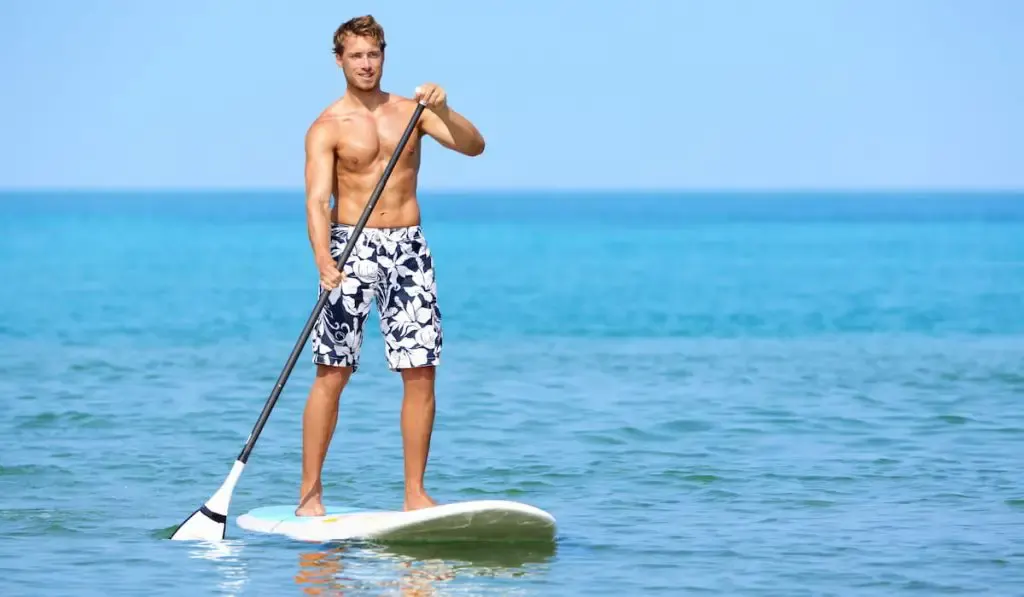Paddleboarding has become a popular activity in recent years, and with good reason. The sport provides a great way to get a workout in the water and is also a refreshing, relaxing way to enjoy the outdoors.
However, if you are new to paddleboarding, it can be overwhelming to know how to paddle to avoid hurting your back.
Paddleboarding is a great core exercise that builds up the muscles supporting your lower back and your spine. But if not done correctly, paddleboarding can be bad for your back.

Stand-Up Paddleboarding and Your Back
Paddleboarding is good for your back and core. When enjoying paddleboarding, you get a full-body workout that incorporates all the muscles in your body.
This is because you engage every part of your body to maintain stability and keep your center of gravity.
Prevents Lower Back Pain
Stand-up paddleboarding can help prevent lower back pain but is not recommended for people recovering from serious back injuries.
However, if you have a history of back problems, you risk re-injuring your back. Therefore, you should consult your doctor before you attempt paddleboarding.
Develops Your Muscles
Paddleboarding helps you develop the muscles that support and protect your lower back and spine by strengthening the muscle throughout your core, from your abdominals to your quadriceps and glutes.
Passive Workout
Standing on top of the board while using your legs and core strength to stay balanced is a passive workout that you should not overlook.
If you want to gradually build your back strength, spend one hour each day paddling on flat water from one place to another, paying close attention to your form, posture, and technique.
Paddleboarding is a good exercise that works your muscles. This is why you will wake up the next day with sore muscles. When paddleboarding, you work your muscles whether standing up, kneeling, or lying down.
The back muscles you work out are the rhomboid muscles that connect to your spine.
What Causes Back Pain When Paddleboarding?

Stand-up paddleboarding is a fun way to work out, catch some waves and enjoy the water! As with any watersport, though, there are dangers associated with it that you should be aware of before attempting to stand-up paddleboard, or SUP.
Bending Over Too Much
One of the biggest dangers of SUP fitness is an injury to your back caused by bending over too much when paddling. Paddleboarding requires forward motion to catch waves. You need to lean low and paddle hard.
If you aren’t aware, this activity can cause lower back pains and injuries if done incorrectly or for long periods.
You are most likely to suffer from lower back pain if you are unfit or you are in poor form, and you will know this if you feel pain or get fatigued in your lower back.
Incorrect Board Size
If you decide to buy a board, be sure that it’s the right size for you. If your board is too large, you’ll find it challenging to keep your balance when paddling, increasing your risk of injury. If you’re not sure what measurements you should get, ask a local shop employee to help you out.
As always, remember that your priority should always be safety when playing around on the water. Always know your limits, and don’t attempt any SUP activity if you feel like there’s even the slightest chance you might hurt yourself.
Even if you don’t have a weak back or preexisting lower back issues, awkwardly positioning yourself while paddling can quickly cause serious injuries.

Spending Too Much Time
Spending too much time on a paddleboard can be harmful to your health. When practicing proper technique, paddling takes a good deal of flexibility in the lower back since this is where power comes from while riding.
You should practice for short periods until you master the proper paddleboarding technique.
Poor Technique
If you spend too much time on a paddleboard, especially with poor technique, you can harm your back and cause serious injury. This is because when you’re paddling and leaning forward to propel yourself through the water, you’re putting constant pressure on your spine as you bend forward at the waist.
If you already have back problems or a weak lower back, paddleboarding is not recommended for you.
If you’re planning on attempting to paddleboard with a pre-existing back problem, be sure to consult with your doctor before going out on the board and make sure that it’s safe for you to do so.
Using a Board That Is Too Large
One of the most common mistakes paddleboarders make, aside from poor technique when paddling, is choosing a board that’s too large. If you find yourself struggling to keep your balance while on the board, no matter how hard you try, you might want to get a smaller board.
When you use a massive paddleboard, you may find yourself fighting to keep steady on the board.
If you are new to the sport, consider renting smaller boards from a local water sports shop until you master the proper technique and have spent significant time strengthening your lower back.
You can always upgrade later on after you’ve mastered the basics of paddleboarding and are ready to take your skills to the next level. Once you’re an advanced paddler who’s confident in balance and technique, chances are that you won’t need a small board anymore.
Before Paddleboarding
Before you hit the water, there are things you can do to help prevent you from hurting your back. They are:
1. Warm-up
Before you hit the water, take a few minutes to do a few quick exercises.
A quick warm-up routine and stretching before and after paddleboarding will help loosen your muscles.
2. Move
Use a paddleboard that moves with your body, so you’re not stuck in one position. A paddleboard that moves with your body, or has adjustable positions, is a better choice than a traditional board, which is only movable in one position.
3. Wear a Paddle Leash
This strap helps keep your paddle from falling off the board. If you will be standing on the board for a long time, use a paddle leash.

Key Takeaway
It is important to remember that the body moves in different ways while you’re out balancing on a paddleboard, so it’s best to consult with your doctor before taking up this sport if you have pre-existing back problems.
In the ever-growing sport of paddleboarding, even seasoned veterans can injure their backs from time to time. However, when you stretch before and after each session you will lower the risk of back injury.
It is vital to practice often with a professional who will help you to avoid injuring yourself and to know the correct technique of different strokes and how much strain they cause your body.
Sources:
- https://www.mensjournal.com/health-fitness/paddleboarding-first-timers-guide/
- https://www.drhomerwalldc.com/blog/paddleboarding-it-s-great-for-your-back-and-core
- https://www.ridingboards.com/is-paddle-boarding-good-for-your-back/
- https://aquasportsplanet.com/the-11-muscles-that-paddle-boarding-works/
